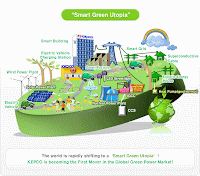The prominent clean-tech research organization
Pike Research has identified top Smart Grid trends that will have higher decibels just not in words but also in action in Smart Grid community in the coming years.With Smart Grid projects being implemented across the world, the Smart Grid community is learning the potential challenges, issues, and opportunities the transformation of the energy infrastructure presents.
1) Smart Grid Security to become top concern
As the Smart Grid implementation gathers pace, security is set to become the one of the top concern in Smart Grid domain. With no standards and protocols defined and with the complexity it possesses, security is going to be the major nightmare for the Smart Grid, which was well analyzed by the experts when the recent Stuxnet virus breakout occurred. And, hence NIST (National Institute of Standards and Technology) has given due weightage by publishing three volumes of "Guidelines for Smart Grid Cyber Security".
2) Distribution Automation will become the Smart Grid Application
The AMI(Automated Metering Infrastructure) or in general sense Smart Meter that has got more publicity so far, it seems that is set to change in the coming years, according to Pike Research. Distribution automation, which includes Demand Response, Electric Cars, and distribution generation is set to take center stage.
3) "Bakersfield Effect" or the loud consumer push back of Smart Grid will continue
Consumer experienced higher electricity bills in California and Texas after implementation of Smart Meters by PG&E and Oncor respectively. Many consumers showed loud opposition to Smart Meter, In addition to this, some Counties in US passed resolution against Smart Meters and Maryland rejected Baltimore Gas and Utilities (BGE's) Smart Meter plan (which they accepted later on with some changes). As the Smart Meter and Smart Grid implantation gathers pace, such events will increase. Industry as whole needs to educate consumers and be ready to address the concern of the consumers, which it seems it wasn't ready in 2010.
4) The Smart Meter and AMI focus will move to China and Europe
With North America leading the Smart Grid implementation in 2010, all the Smart Meters and AMI buzz was in US and Canada. It seems to change from 2011, as Europe, which spearheaded the Smart Meters implementation, and China are set to have largest numbers of Smart Meters implementations in coming years. Europe is planning implement 100 million Smart Meters, notable among them is Spain, UK, France, and Germany. China, which is leading the Smart grid investment pack in 2010 is set to rollout 750 million Smart Meters by 2020, according to Pike Research.
5) HAN will be in waiting ..
HAN (not the Chinese name) the Home Area Network,with agreed basic Zigbee standards and available critical mass of Smart Meters in 2010, was supposed to gain momentum. However, with changes in standards, integration of IP in the standards, and due to "Bakersfield Effect", It will have its first implementation in sometime middle of 2011 and the real growth may happen in 2012.
6) Demand Response will accelerate
The companies like EnerNOC, which are into business of offering benefits to customers who reduce the energy usage during certain time period, which is also know as curtailment services, will gather momentum in coming years. Also, companies like Honeywell, Siemens, and Johnson controls, which provide services and products for Energy Management Services (EMS) will enter in this domain. IT companies like Cisco and IBM are also investigating EMS space with their new products and may disrupt the DR domain with advance offering of EMS and DR.
7) Smart Grid stimulus will start showing its impact
The US government's $3.4 billion stimulus package announced in 2009 and allocated in 2010 will show its impact from 2011 onwards. The funds have accelerated the process of standards, educational and training program are being prepared that will provide skilled workforce, and pilots will provide the much needed experiment for the full roll out.
8) Standards will catch up with the deployment efforts
Without standards no big complex system can function effectively, having known this, Smart Grid community is working on setting up common standards for its ecosystem. Nonetheless, the effort so far have lagged behind the actual implementation, which is more so accurate in the case of AMI. Worldwide, there are various standards and protocols that are being adopted, Within US itself IP, Zigbee, propriety mesh, Wi-Fi, and others are being adopted by utilities and their vendors.The interaction between this standards, and what standards to be adopted still being discussed, however, US and Europe seems to finally coming up with the Standards that will catch with the deployment.
9) Data management will be the next major challenge for Smart Grid
With the implementation of Smart Meters or AMI and other Smart Grid technologies, utilities will start gathering data at every 15 minutes or in some cases less than that, which is set to create an ocean of data that needs to manage, maintain, and analyze. Essentially, it will require new, advanced, and better IT technology, skills, and expertise. According to Pike Research "The smart grid is driving utility back-end IT systems and applications toward an even more radical transformation than the communications infrastructure". Collecting the data, integrating in the system, transforming into useful information, and transmitting to its users in timely manner is going to be the daunting task for the industry.
10) Data and Telecom vendors will become serious about Smart Grid
Top telecom companies Vodafone, AT&T, Verizon, and others are emerging as serious players in the Smart Grid industry by offering their communication infrastructure to utilities. More Partnership like Cicso and Itron will emerge in the coming years and 2011 may be the transformative year for the Telecom companies.





















